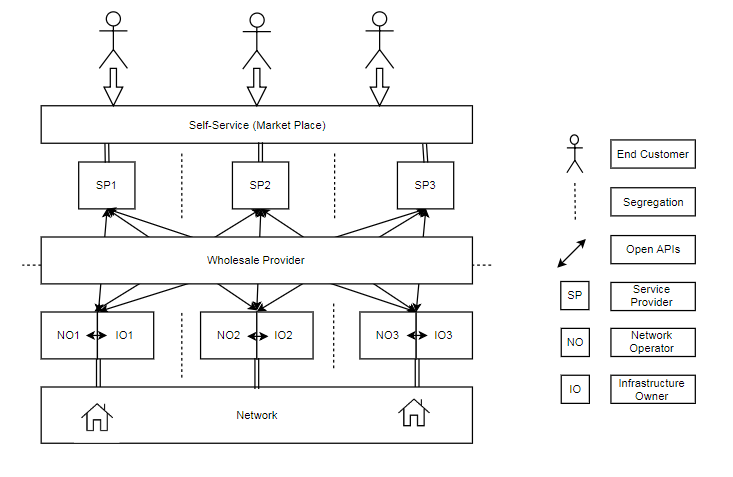Sharing Economy in the Telecommunications Industry: Open Access in Fibre Networks – Part 3

Open Access models are levelling the playing field for operators by offering a convenient plug-and-play infrastructure without heavy capital expenditure. In the third and last part of this blog series, Mukesh Binani looks closely at the revenue model, technical architecture, key features and implementation of Open Access in Fibre Networks.
Until now, we have examined how the low risk, low investment and high return model of Open Access Networks (OANs) can help Communications Services Providers (CSPs) improve customer satisfaction and maximise utilisation of resources for fibre owners. However, in order to make the most of the open access approach, the OAN implementation must be based on openness, simplification, on-demand access and automation which, in turn, provides confidence to all stakeholders along with maximum return on investment.
Revenue Sharing Model
 There can be various approaches to revenue sharing in Open Access Networks, either in fixed or percentage terms. For instance, one of the approaches in the wholesale model could be:
There can be various approaches to revenue sharing in Open Access Networks, either in fixed or percentage terms. For instance, one of the approaches in the wholesale model could be:
- End Customers pay Service Providers for service and support.
- Service Providers pay the Wholesale Provider for operations.
- Infrastructure Owner pays the Wholesale Provider for operation of the platform.
- Wholesale Provider pays the Infrastructure Owner for actual investment and service.
- Infrastructure Owner pays the Network Operator for maintaining the network and support.
Note that the Infrastructure Owner and Network Operator are often the same entity. In some cases, the Wholesale Provider may also run their own retail Service Provider business, but the wholesale business must offer equal access to all its Service Provider partners.
Approaches like these provide a new market opportunity for the stakeholders involved, allowing customers to benefit from competitive pricing, while enabling different Service Providers to offer more competitive products and services. The Infrastructure Owner, Network Operator and Wholesale Provider all benefit from the cumulative increase in services using the network. The model also gives equal access to all Service Providers if multiple entities belong to the same company.
Open Access Model Architecture

In an OAN model, multiple Service Providers are part of the same marketplace.
End Customers should be able to use a self-service platform to choose services from any provider with the minimum of effort.
For Service Providers, it should be easy to add customers and order the required services via the wholesale platform.
For the Wholesale Provider, the data should be validated and flow smoothly between the different entities.
For the Infrastructure Owner/Network Operator, all required information should be available to progress and fulfil the order.
Key Features of Retail BSS/OSS Systems
For retail customers, a single bill should be provided for the services across all networks and it should be possible to take orders easily. Furthermore, an omnichannel approach to communicating with customers is essential, with all information readily accessible at each touchpoint.
The BSS/OSS system must include features like a flexible product catalogue, segmentation and CPQ (Configure, Price, Quote) to maximise new revenue opportunities for Service Providers. To attract new customers, it should also include campaign management, promotions and discounting features.
The system should include other features such as engineer appointment management along with outage/fault notifications and meeting SLAs for planned and unplanned (proactive and reactive) engineering work, for better operations processes under the Infrastructure Owner / Network Operator. It should also include revenue management and assurance systems along with fraud management capabilities.
Key Features of Wholesale BSS/OSS Systems
For customer segmentation, the wholesale system should be multi-tenant in nature. Security and segregation between entities is vital as data protection becomes increasingly important. The system should also include a wholesale product catalogue and support hierarchical billing structures, as well as multi-party settlement for all wholesale partners with revenue assurance and reconciliation reports. These features help to create accurate invoices which results in trust between the entities. The system should also be able to generate analytics-based reports and dashboards for all hosted entities on the platform, and the activation of services should be done in an optimised manner when choosing between multiple networks.
General Implementation Rules for BSS/OSS in Open Access Networks
Here are a few key principles which should be used when implementing BSS/OSS platforms for the Wholesale Open Access Model:
- Open APIs implemented in RESTful interfaces - These APIs are exposed for the entities to consume via various services, allowing each company to implement their business model in a more cost-effective, timely and agile fashion. It provides the required business agility for digital transformation.
- Microservices architecture for loosely coupled services - This is another important part of the BSS/OSS platform which helps to maintain and scale each feature independently. It also allows the introduction of new services without impacting those which are already running.
- Enterprise Service Bus (ESB) framework - Integration should be encapsulated within an ESB framework in a service-oriented architecture (SOA). An ESB framework can help in orchestration for different entities and transformation of various messages in different patterns.
- Robust security - Firewalls, DMZ and authentication should be implemented with the help of tokens and external certificates. The defined roles and rules for data access keeps data segregated for each entity.
- Continuous Integration/Delivery/Deployment/Testing (CI/D/D/T) - Build, deploy and test the delivery in an automated fashion using continuous integration and holistic DevOps processes. This automation helps to bring the latest stable software and product to market faster. It helps the Service Provider to outmanoeuvre their competitors and stay ahead in their business, increasing ROI for everyone.
- High availability - The system should offer high availability for all critical tasks. Keeping the system up and running reduces revenue loss and maintains strong client relationships. It also helps during hardware and software updates by creating a resilient system. Furthermore, it should be able to seamlessly support thousands of concurrent requests using load balancing for a good user experience.
- Established standards - The complete solution should be implemented using recognised industry frameworks and business processes. This helps to simplify the IT architecture and reduce integration costs and risks. It should also support local regulations, multiple languages and multiple currencies in addition to being hardware agnostic.
The Road Ahead
Open Access models are becomingly increasingly popular across the globe as both governments and telcos understand the benefits they can bring for businesses and consumers. Not only are they helping connect once disconnected rural areas worldwide, they are also paving the way for smart cities, smart grids, telemedicine and the Internet of Things (IoT). Moreover, all of this is offered in a secure, sustainable and economical fashion - and that by far is the biggest advantage of Open Access Networks.
Cerillion’s Enterprise BSS/OSS suite supports implementation of the open access model by offering Service Providers and Wholesale Providers a comprehensive way to deliver their services and manage their business relationships. Contact us today to find out more.
Read Part 1 and Part 2 of this blog series.
